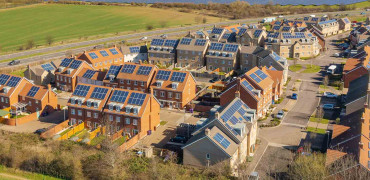The Government received a timely boost from the most recent auction of clean energy projects, which could provide electricity for 11 million homes so long as the National Grid can cope with rising levels of demand for energy from householders and drivers.
A total of 131 projects, principally offshore wind turbines and solar farms, as well as onshore wind and tidal energy were supported.
This represented a huge turnaround from last year which saw zero offshore wind projects agreed.
Nine of the contracts awarded were for what will be Europe’s largest and second largest windfarm projects, Hornsea 3 and Hornsea 4 off the Yorkshire coast.
It also included securing the largest commercial floating offshore wind project (Green Volt) in the world, which is double the size of Europe’s total installed floating offshore wind capacity.
Six new tidal projects constitute just under half of the world’s operational tidal stream capacity, building on the UK’s world leading position for this type of energy production.
This is a "significant step forward" in achieving "energy independence and lower bills for good"
Much lower cost
The projects have also been agreed at well below the upper limit on the price set for the auction – meaning the Government has bought a record amount of clean power at much lower cost to consumers than the maximum price – providing value for money and cheap power.
Gas and electricity prices rose significantly in 2021 as the global economy began to re-open from lockdowns implemented in the Covid pandemic.
The increase accelerated the following year following the invasion of Ukraine by Russia, which is one of the world’s biggest producers of oil and gas.
While the long-term aim of Ministers is to bring energy prices down and lessen the UK's reliance on overseas providers, it will take some time for consumers to benefit. Household bills are expected to rise next month after the energy regulator Ofgem lifted the cap on the price paid for each unit of gas and electricity used in 27 million homes in England, Wales and Scotland.
From October, a typical household's annual energy bill will rise by £149. People using an average amount of gas and electricity will pay £1,717 a year.
Decarbonising the grid
The announcement of the successful auction is the latest step in the new Labour Government’s drive to accelerate the mission for clean, secure power by 2030. In just three months the Government has:
- lifted the ban on onshore wind in England;
- launched Great British Energy in partnership with the Crown Estate, backed by £8.3 billion of new money, which is estimated to create up to 20-30GW of new offshore wind developments reaching seabed lease stage by 2030;
- approved 3 major solar farms powering the equivalent of around 400,000 new homes; and
- launched its Clean Energy Mission Control centre, led by former Climate Change Committee Chief Executive Chris Stark, to accelerate the deployment of clean power.
A clean energy superpower
All these measures combined will support Labour’s mission to decarbonise the electricity grid by 2030 and hit net zero in 2050, helping transform the country into what Ministers are calling ‘a clean energy superpower’.
Ed Milliband, the Energy Secretary hailed the auction as a "significant step forward" in the Government's aim of achieving "energy independence and lower bills for good". He is now working with the industry to accelerate ways that the Contracts for Difference system and other energy policies can be expanded, so that more renewable energy, including offshore wind, can be connected to the grid, and quicker.
This will present an unprecedented challenge for the national grid which was originally built to transmit power generated by a few large power stations to homes and businesses that had lower overall demand.
The biggest challenges to the smooth running of the electricity grid are expected to come from heat pumps’ use (as we transition from gas boilers) and electric vehicle charging IF consumers’ purchases increase in line with projections. Indeed the UK’s annual electricity demand is expected to have doubled by January 2035.
Power outage fears
It has been speculated that a spell of cold weather could cause a collective surge in power demand from millions of households, which could even cause power blackouts, particularly if cold, Wintery weather coincided with light or intermittent winds in the North Sea.
These fears have been stoked by organisations including the Stove Industry Association, which represents companies in the wood-burning stove industry. Erica Malkin, the group’s spokesperson, told the Daily Express there were “concerns about the expansion of the energy network” and the “very real potential for power outages”.
“The electrification of heat is a sound argument when it comes to carbon-saving, but when it comes to grid dependency we are nowhere near the targets for what would be needed to entirely electricity heat in this country,” she said.
She told the newspaper that in the event of a blackout, households would not be able to heat their homes and might find it beneficial to have a wood burning stove instead. I assume that when Ms Malkin made that final comment, she had her tongue very firmly in her cheek.
The amount of electricity generated by the UK’s gas and coal power plants fell by 20% last year to its lowest level since 1957. Renewable energy provided the single largest source of power at 42%, although gas power plants still accounted for 31%.
National Grid ESO (NESO), which balances Britain’s electricity supply and demand, would reject the suggestion that there is no “satisfactory explanation” for how it will keep the lights on in Britain’s green electricity future.
The electricity system operator produces detailed annual forecasts of Britain’s various potential routes towards its climate goals, as well as studies that analyse the changes expected to the UK’s power supplies and electricity demand.
Cold, winter’s day
These reports provide a blueprint that is used by the industry and Government officials to prepare the grid for the future. In one report, the grid operator has modelled a ‘typical winter’s day’ in the fourth week of January 2035, which provides a snapshot of how heat pumps will be integrated into the electricity system.
On this day NESO assumes that renewable energy will be only 40% of the UK’s total generation due to low levels of solar and wind power generation in still, overcast weather.
Instead, the UK would meet its power demand by using extra gas and biomass power plants fitted with carbon capture technology, as well as power imports from neighbouring countries via electricity interconnectors and green hydrogen derived from renewable electricity.
Importantly, the model forecasts an increasingly digital power grid capable of making better use of the UK’s renewable energy sources when they are available. This means that even though the UK’s annual electricity consumption will double overall, the peaks of electricity use will not be twice as high.
For example, homes and businesses can charge their electric vehicles or batteries overnight when power demand is lower, helping to keep the daily power use peak from climbing too high. These same energy stores could even help keep the lights on by releasing electricity back to the grid at times when demand for power reaches a peak.
In one forecast, Scottish Power, which runs regional networks as well as major transmission lines, has created an artificial intelligence-powered “digital twin” of its electricity networks to simulate how they might change by 2045.
One of its key findings is that using heat pumps flexibly could help to reduce their contribution to peak demand by up to 32% by 2045, making it easier to keep the energy grid stable.
Monitoring power use and demand
UK Power Networks (UKPN), which runs the grids serving London and parts of the south-east of England, is already monitoring real-time data from homes that have electric heating alongside an electric vehicle charger, solar panels or batteries, to understand the impact that heat pumps will have on the grid.
UKPN’s project, which it is running with the Energy Systems Catapult (ESC), will help “improve understanding of the expected impact of heat pumps on the power network as domestic heating is increasingly electrified, and provide tools to manage these changes”, the company said. “This will allow UK Power Networks to ensure they invest in network upgrade and development more efficiently, and so reduce customer bills.”
The forecasts undertaken by NESO were prepared under the UK’s previous government, which aimed to run a net zero electricity grid by 2035. Under the new Labour government this target is expected to come forward to 2030, meaning the rollout of renewables will need to be even faster than the previous target, which was itself considered ambitious by the industry. This may make it trickier to manage the influx of heat pumps by the end of the decade.
The existing targets also suggest a combination of heat pumps alongside hydrogen boilers, although hydrogen boilers are expected by experts to play a more limited role than first imagined, meaning heat pumps could be required to play a larger role than NESO is prepared for. The Government is due to make a final decision on the role of hydrogen heating in the UK’s net zero future by 2026, but until then forecasts will include hydrogen heating.
Of course, there is still time for energy grids to evolve before heat pumps have an adverse impact on the UK’s electricity system. It will no doubt be trickier for the grid operators to keep the lights on than it was in the past – but there is no reason to believe the UK will experience more blackouts in the future if careful modelling and upgrades continue.
Patrick Mooney is News editor, Housing Management & Maintenance




